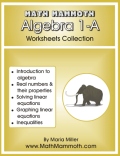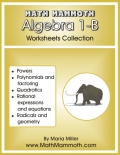We all know that youngsters often have this question in mind when they go on in their math studies:
where or when will I ever need all this?It's pretty easy and simple to find applications and real-life examples for the usage of the simple, elementary math, such as multiplication tables or decimals and percents. But when we go on to algebra and beyond, this question may be harder to answer.
Here are a few answers you can give as to why study algebra:
- You need it in any occupational field that requires higher education, such as computer science, electronics, engineering, medicine (doctors), trade and commerce analysts, ALL scientists, etc. In short, if someone is even considering higher education, they should study algebra. You need algebra to take your SAT test or GED.
- Algebra also lets you develop logical thinking and problem solving skills. It can increase your intelligence! Actually, studying any math topic can do that (even elementary math), if the mathematics is presented and taught in such a manner as to develop a person's thinking.
Now, it's no big secret that mathematical concepts in algebra and beyond are
not needed in every single occupation, especially in those of mostly manual labor. (You can check
Math Careers Database for the math requirements of 277 major occupations.)
But, ask your students if they are
100% sure what they are going to do as adults? Most kids in middle school are not. If they are not 100% sure, they'd better study algebra and learn all the math they can so that when they finally have some idea, they won't be stopped from a career because of not having studied algebra, geometry, or calculus. (This has definitely happened to many folks.)
Besides, in today's world many people have to change careers even during their work life. So I would recommend young people to get a good solid basic education, just so they are well prepared and also so they.

Now, beyond these thoughts, there also exist SEVERAL find websites dedicated to these issues, so I want to highlight them here.
The website
Future's Channel has short movies, lesson guides, and student worksheets that show how algebra is used in with real word applications, such as roller coasters, banking, rice production, skyscrapers, solar power, and lots more. These video clips are really well made and can motivate students to choose a career where math is used.

Another site to check is
Make It Real Learning and their
free worksheets. These worksheets focus on answering the question, "When am I ever going to use this?" They also sell worksheets, and as a special
BONUS, visitors of this site get
30% off their regular pricing with the coupon code "save30". This applies to ANY worksheet or worksheet bundle sold on the site.
Then,
Micron: Math in the Workplace contains a collection of real-world math problems and challenges contributed by a variety of businesses, demonstrating the relevance of math in today's world.
Yet more resources
Career profilesEssays from authors from a variety of careers for which a background in the mathematical sciences is useful.
Examining How Mathematics is Used in the WorkplaceMathematics in Automobile Production; Proportional Reasoning by Nurses; Modeling the Mathematics of Banking; Mathematical Models as Seen by Biologists; How do Scientists Interpret Graphs?
Mathematical Moments - a series of one-page PDF files that promote appreciation and understanding of the role mathematics plays in science, nature, technology, and human culture. The one-page flyers cover very diverse topics such as findign oil, solving crimes, DNA, brain, traffic, aircraft design, etc.
Where do you need exponents in everyday life? - my article.
Math in TechnologyFully written out examples of how various areas of mathematics are applied to various areas of technology.
Career profiles in mathematical sciencesIf you were a math major, what kind of jobs could you end up with?








